يشبه تحليل البيانات محاولة تعلم لغة أخرى. تأتي كل مجموعة بيانات برموزها ومعانيها وعلاقاتها الخاصة بها.
لا تخف، لأن أدوات تصور البيانات موجودة هنا لتعمل كمترجمين شخصيين لك، حيث تعمل على سد الفجوة بين مجموعات البيانات الغامضة و وفهم فريقك من خلال تحويل البيانات الغامضة إلى مخططات ورسوم بيانية وصور واضحة وبسيطة.
من خلال تحويل البيانات الأولية إلى قصص مقنعة بصريًا، تساعدك هذه الأدوات على توصيل رؤى معقدة بلغة تتناسب مع الجميع، بغض النظر عن مدى إلمامهم بالبيانات.
لقد اخترنا لك أفضل أدوات تصور البيانات لمساعدتك في فك شفرة الدروس والاتجاهات المخفية في بياناتك. سنناقش إيجابيات وسلبيات كل أداة من هذه الأدوات، ونزودك بالرؤى التي تحتاجها لاختيار المترجم المثالي لمتطلبات فريقك الفريدة.
دعنا نكسر هذه الحواجز اللغوية معًا!

ما هي أدوات تصور البيانات؟
أدوات تصور البيانات هي تطبيقات برمجية تمكّن المستخدمين من إنشاء تمثيلات مرئية للبيانات والمعلومات. تتيح هذه الأدوات للمستخدمين تقديم بيانات معقدة بطريقة سهلة الفهم وجذابة بصريًا.
الغرض الرئيسي من أدوات تصور البيانات هو تسهيل تفسير البيانات على المستخدمين واستخلاص رؤى ذات مغزى منها.
ما الذي يجب أن تبحث عنه في أدوات تصور البيانات؟
أنت بحاجة إلى أداة لتصور البيانات تفهم لغة فريقك وتتواصل مع جمهورك وتنقل بدقة القصة المخفية في بياناتك. لمساعدتك في اتخاذ القرار الصحيح، قمنا بتجميع قائمة بالعوامل الرئيسية التي يجب مراعاتها عند تقييم أدوات تصورات البيانات:
- سهولة الاستخدام: ابحث عن أداة تسهّل على المستخدمين من جميع مستويات المهارة إنشاء عروض مرئية جذابة وغنية بالمعلومات لبياناتك. فالأداة سهلة الاستخدام تحوّل فريقك إلى رواة للبيانات دون الحاجة إلى معرفة تقنية واسعة.
- التخصيص: يجب أن تسمح لك أداة تحليل البيانات الخاصة بك بتخصيص مرئياتك لتتناسب مع هوية علامتك التجارية وتفضيلات الجمهور وأهداف التواصل المحددة. ستضمن لك القدرة على ضبط تصوراتك المرئية بدقة أن تكون فعالة وجذابة بصريًا.
- التكامل: التكامل السلس مع مصادر بياناتك ومنصاتك الحالية أمر ضروري. يجب أن تكون أداة تحليل البيانات متعددة الاستخدامات قادرة على الاتصال بتنسيقات بيانات مختلفة، مثل CSV أو Excel أو SQLقواعد البياناتوالتكامل مع منصات التواصل الاجتماعي الشهيرة وتطبيقات الأعمال مثل Salesforce أو Google Analytics.
- التعاون: يجب أن تسمح أدوات تصور البيانات القوية لعدة مستخدمين بالعمل معًا في الوقت الفعلي من أجل سلاسةتنفيذ المشروع. تعمل ميزات مثل التعليق والمشاركة والتحكم في الإصدار على تحسين كفاءة سير عمل فريقك وتؤدي إلى نتائج أكثر وضوحًا.
- قابلية التوسع: مع نمو أعمالك، تنمو بياناتك أيضًا. اختر أدوات تصور البيانات التي تتناسب مع احتياجاتك وتتعامل مع مجموعات بيانات أكبر وتصورات بيانات أكثر تعقيدًا دون المساس بالأداء أو الوظائف.
- الدعم والموارد: مكتبة واسعة من الموارد، مثل البرامج التعليمية والندوات عبر الإنترنت ودعم العملاء، لا تقدر بثمن عند إتقان أدوات جديدة لتصور البيانات. تأكد من أن الحل الذي اخترته يوفر الدعم اللازم لمساعدة فريقك على استخدام الأداة وإطلاق العنان لإمكاناتها الكاملة.
ضع هذه المعايير في اعتبارك بينما نتعمق أكثر في أفضل 10 أدوات لتصور البيانات، وستكون على بعد خطوة واحدة من ترجمة بياناتك المعقدة إلى رؤى مذهلة بصريًا وسهلة الفهم.
أفضل 10 أدوات لتصور البيانات لعام 2024
لكل أداة نقاط قوتها ونقاط ضعفها الفريدة، والتي تلبي الاحتياجات والتفضيلات المختلفة. في هذا القسم، سنقدم نظرة عامة على هذه الأدوات، وسنسلط الضوء على ميزاتها الرئيسية وإيجابياتها وسلبياتها لمساعدتك في تحديد ما يناسب فريقك تمامًا.
1. انقر فوق أفضل أداة لتصور البيانات لإدارة المشاريع

اجمع كل أعمالك معًا في نظرة عامة عالية المستوى باستخدام لوحات المعلومات
ClickUp هو برنامج متعدد الاستخدامات لإدارة المشاريع و أداة إنتاجية مصممة لتبسيط التعاون والتنظيم و التواصل بين أصحاب المصلحة . بالإضافة إلى مجموعة شاملة من الميزات، يتميز ClickUp بإمكانيات قوية لتصور البيانات التي يمكن أن ترتقي بتحليل بياناتك إلى المستوى التالي.
يتيح ClickUp للمستخدمين إنشاء مخططات ورسوم بيانية ومخططات و تقارير التخطيط الاستراتيجي بفضل واجهة سهلة الاستخدام و لوحة تحكم قابلة للتخصيص . يؤدي تكاملها السلس مع مصادر البيانات المختلفة وتطبيقات الأعمال الشائعة إلى سير عمل سلس وفعال، في حين أن التعاون في الوقت الفعلي تعمل الميزات على تعزيز العمل الجماعي وإبقاء الجميع متزامنين.
مع ClickUp، ستستمتع بمنصة موحّدة لإدارة المشاريع وسرد البيانات، مما يمكّن فريقك من اتخاذ قرارات مستنيرة وتحقيق النجاح.
مكافأة:_
_/href/ /مدونة؟ ص=65846 برامج التخطيط الاستراتيجي** %/href/*
!
ClickUp أفضل الميزات:
تتفوق Clickup في صنع التشغيل الآلي سهل الإعداد، مما يوفر على المستخدمين الوقت والجهد. تعمل وظيفة الكل في واحد وإمكانيات التكامل على تبسيط إدارة العمل مع توفير إمكانية الوصول إلى كل من التقارير ولوحات المعلومات المُنشأة مسبقًا والمخصصة.
تسمح الواجهة سهلة الاستخدام وفي الوقت الفعلي باتخاذ قرارات سريعة حتى تتمكن من إدارة مشاريعك بشكل استباقي لتجنب زحف النطاق . كليك أب وثائق المشروع تسمح الميزات للفرق بالإضافة إلى مستودع المعرفة الخاص بهم بعد كل سباق سريع ما بعد الوفاة .
قيود ClickUp
قد يمثل ClickUp تحديًا للبعض بسبب تخصيصاته وميزاته المعقدة. لا تتوافر جميع طرق العرض على الهاتف المحمول (حتى الآن)، وهو ما قد لا يكون مثاليًا لمحللي البيانات الراغبين في العمل أثناء التنقل.
أسعار ClickUp:
- مجاني للأبد
- غير محدود: 7 دولارات شهريًا لكل مستخدم
- شركة: 12 دولارًا شهريًا لكل مستخدم
- شركة بالإضافة إلى: 19 دولارًا/شهرًا لكل مستخدم
- المؤسسات: اتصل لمعرفة الأسعار
ClickUp التقييمات والمراجعات:
- G2: 4.7/5 (6,670+ تقييم)
- Capterra: 4.7/5 (أكثر من 3,640 تقييم)
2. جوجل لوكير ستوديو
أفضل أداة لتصور البيانات من أجل المرونة
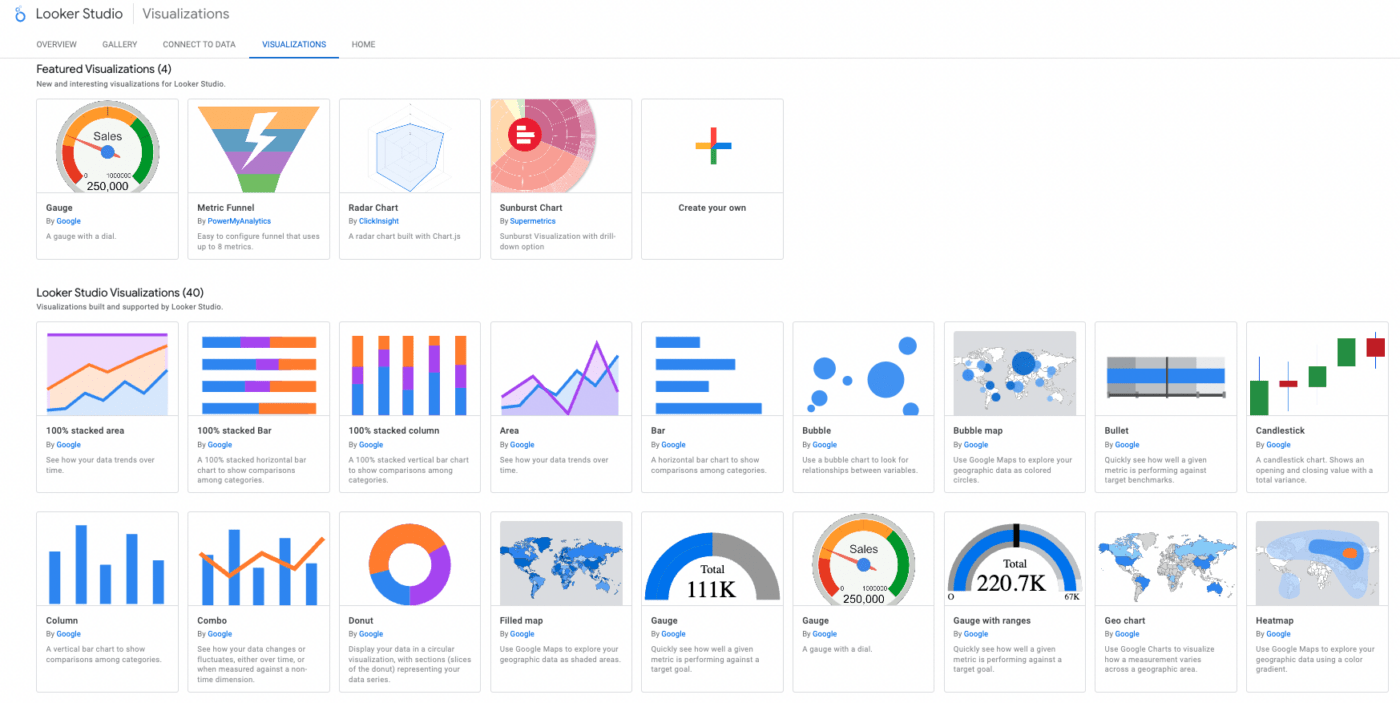
عبر جوجل Google Looker Studio عبارة عن منصة متطورة لتصور البيانات والتحليلات تساعد الشركات على استكشاف بياناتها وتحليلها بمرونة لا مثيل لها. صُمِّمت أداة Google هذه لتلائم احتياجات فريقك الفريدة، وهي مصممة لتلبية الاحتياجات الفريدة لفريقك، وتوفر مجموعة واسعة من خيارات التخصيص، مما يتيح لك إنشاء تصورات مصممة خصيصًا لنقل القصة المخفية في بياناتك ببضع نقرات فقط.
يمكن للفرق إنشاء مخططات تفاعلية ولوحات معلومات وتقارير تفاعلية تبث الحياة في بياناتهم. كما أنها تتكيف بسهولة مع احتياجاتك، دون المساس بالوظائف.
أفضل ميزات Google Looker Studio:
Looker Studio هي أداة ذكاء أعمال قائمة على السحابة من Google يمكن الوصول إليها عن بُعد، مما يجعلها ملائمة لمحللي البيانات أثناء التنقل. يقوم تلقائيًا بإنشاء تصورات للبيانات ويسمح للمستخدمين بما يلي إنشاء تصوراتهم الخاصة ولوحات المعلومات التفاعلية. تعمل المنصة على تبسيط جدولة التقارير، مما يسهل من التواصل مع العملاء على نقاط البيانات المهمة.
قيود Google Looker Studio
على الجانب السلبي، يقول بعض المراجعين أن هناك بطء في تحميل التقارير وأن الأداة توفر مرونة محدودة للاستعلامات والتحليلات المعقدة. وتقول مراجعات أخرى إن الوثائق المقدمة غير كافية، وتفتقر الأداة إلى وظائف الرسوم البيانية المتقدمة مقارنةً بأدوات ذكاء الأعمال الأخرى.
تسعير Google Looker Studio:
- المنشئون وعارضو التقارير: مجانًا
- المؤسسات: اتصل لمعرفة الأسعار
تقييمات ومراجعات Google Looker Studio:
- G2: 4.4/5 (أكثر من 370+ تقييم)
- كابيترا: 4.5/5 (193+ تقييم)
3. مايكروسوفت باور بي آي
أفضل أداة لتصور البيانات لذكاء الأعمال
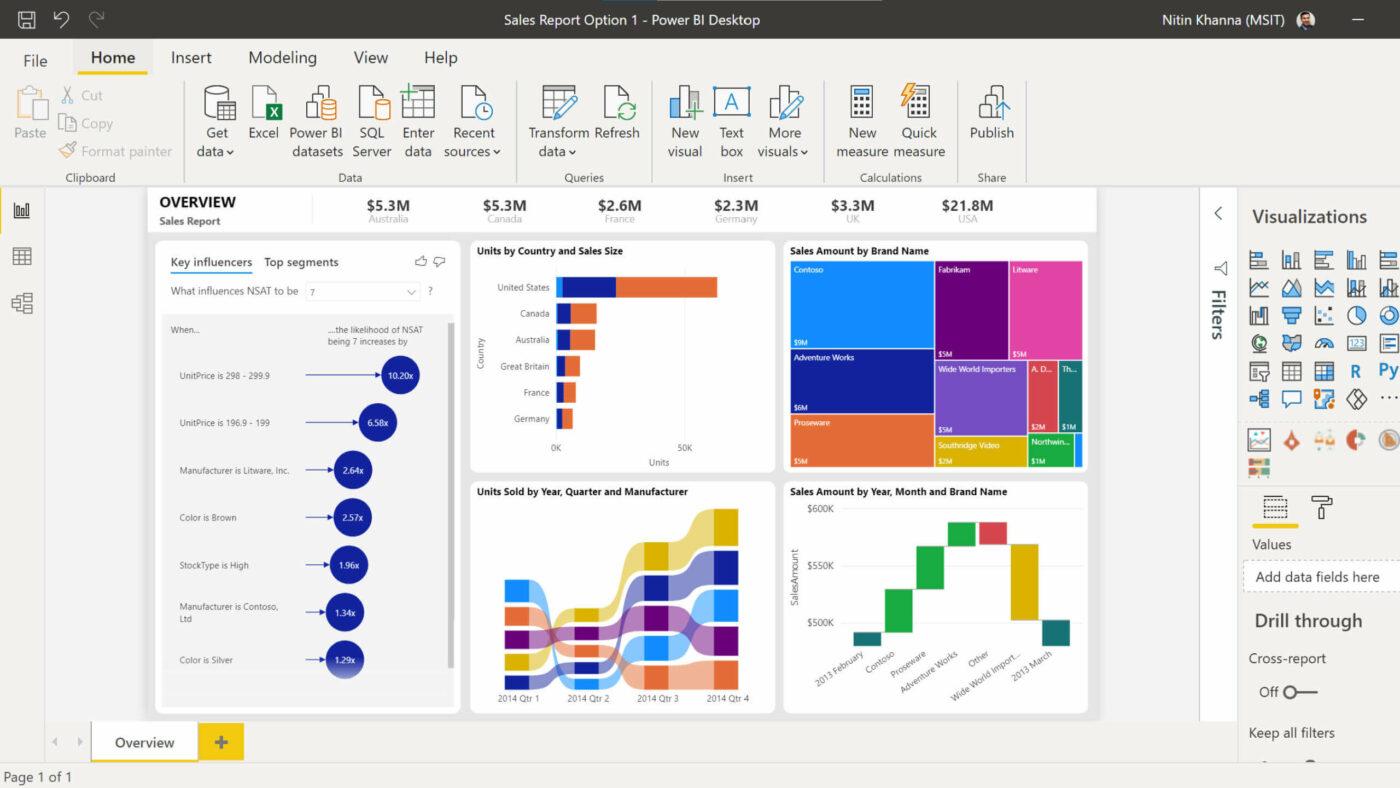
عبر Microsoft Power BI
بفضل مجموعته الواسعة من خيارات التصور التفاعلي، يمكّن Microsoft Power BI المستخدمين من إنشاء تقارير ولوحات معلومات مذهلة وسهلة الفهم تدفع عملية اتخاذ القرارات المستندة إلى البيانات. وباعتبارها واحدة من أفضل أدوات تصور البيانات لذكاء الأعمال، تتفوق Power BI في التكامل مع مجموعة واسعة من مصادر البيانات، مما يسهل دمج البيانات وتحليلها من جميع أنحاء مؤسستك.
كما أن واجهة Power BI سهلة الاستخدام والتكامل السلس مع تطبيقات Microsoft الأخرى يجعلها خيارًا مثاليًا للشركات التي تتطلع إلى تسخير قوة بياناتها.
أفضل ميزات Microsoft Power BI:
يتصل Microsoft Power BI بمجموعة كبيرة من مصادر البيانات مثل Google Analytics وFacebook وSQL وملفات البيانات والملفات السحابية. يوفر مجموعة رائعة من أنواع المخططات ويتميز بواجهة سحب وإفلات سهلة الاستخدام لإنشاء تقارير ولوحات معلومات تفاعلية.
قيود Microsoft Power BI:
يرى البعض أن واجهة المستخدم غير متقنة، كما أن إعداد نموذج البيانات ليس بديهيًا للغاية. كما أن المستخدمين مقيدون أيضًا بسبب عدم القدرة على استخدام مجموعات بيانات متعددة كمصادر، ونقص خيارات مصادر البيانات، وخيارات التخصيص المحدودة للمرئيات.
تسعير Microsoft Power BI:
- Power BI Pro: 10 دولارات شهريًا لكل مستخدم
- Power BI Premium: 20 دولارًا شهريًا لكل مستخدم
- باور بي آي بريميوم لكل سعة: بدءاً من 4,995 دولاراً شهرياً
تقييمات ومراجعات Microsoft Power BI:
- G2: 4.4/5 (920+ تقييم)
- Capterra: 4.6/5 (1,380+ تقييم)
4. تابلو
أفضل أداة لتصور البيانات للمؤسسات
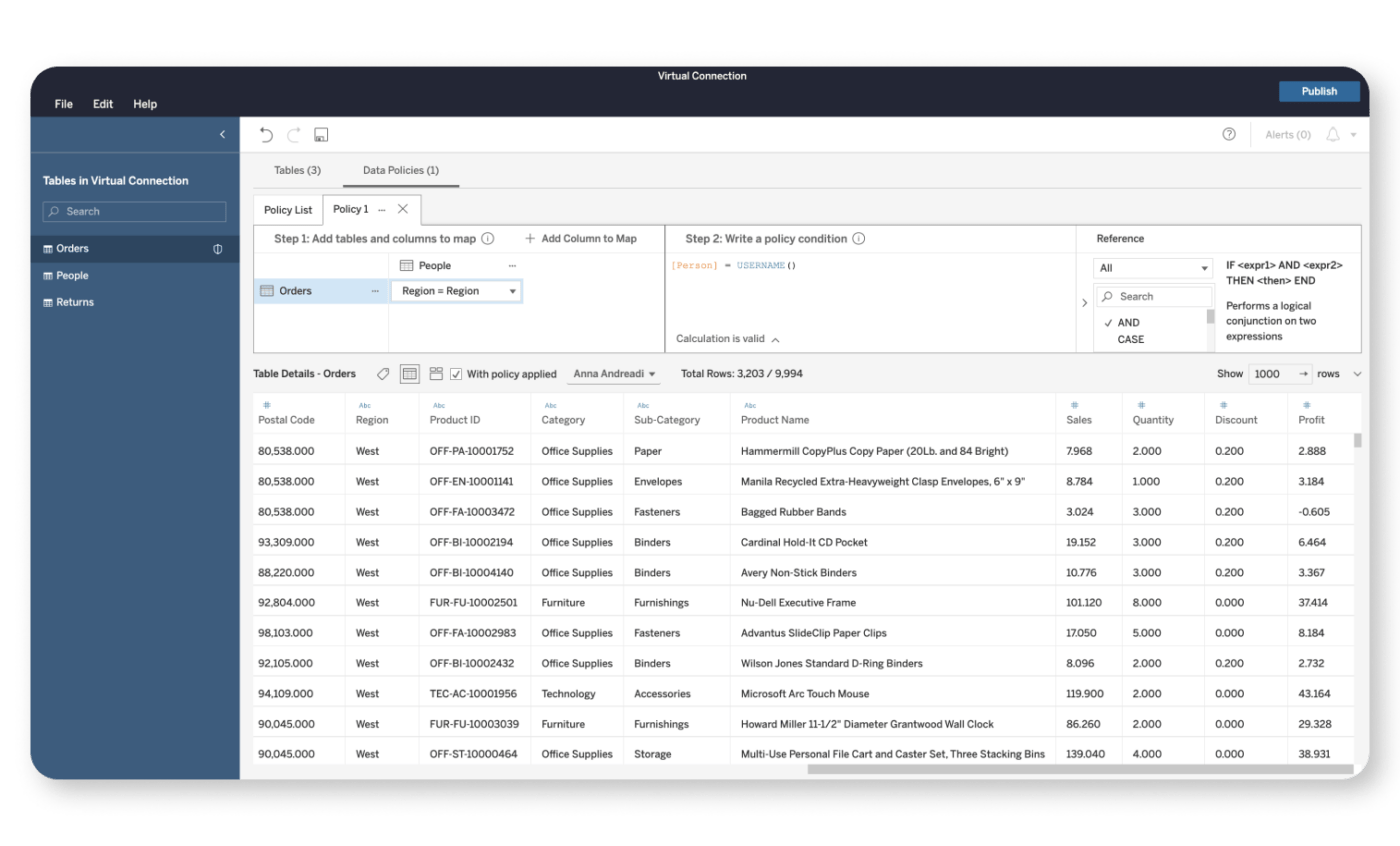
عبر تابلو Tableau هو نظام أساسي شهير لتصور البيانات والتحليلات يلبي الاحتياجات الفريدة للشركات الكبيرة. بفضل قدراته القوية في مجال ذكاء الأعمال ومعالجة البيانات، يتفوق Tableau في معالجة كميات هائلة من البيانات وتحليلها، مما يمكّن المؤسسات من الكشف عن الرؤى والاتجاهات القيّمة.
تقدم المنصة مجموعة واسعة من الطرق لتصور البيانات، مما يسمح للمستخدمين بإنشاء مرئيات تفاعلية مقنعة يمكن مشاركتها واستكشافها بسهولة. كما أن تركيز Tableau على الأمان وقابلية التوسع يجعله الخيار الأفضل للمؤسسات الكبيرة التي تسعى إلى تنفيذ أدوات تصور البيانات التي يمكن أن تنمو جنبًا إلى جنب مع أعمالها.
إذا كنت جزءًا من مؤسسة كبيرة تبحث عن أداة قوية لتحليل البيانات على مستوى المؤسسات يمكنها التعامل مع نقاط البيانات الضخمة وتقديم تصورات متطورة، فيجب أن يكون Tableau على رأس قائمة اعتباراتك.
أفضل ميزات Tableau:
يجعل Tableau من السهل للغاية إنشاء تصورات معقدة للبيانات بأقل جهد ممكن، وذلك بفضل واجهة السحب والإفلات. يتميز بواجهة سهلة الاستخدام ويمكنه الاتصال بمجموعة متنوعة من مصادر البيانات. بالإضافة إلى ذلك، فهو يتميز بلوحات معلومات تفاعلية لتحسين تجربة المستخدم.
قيود برنامج Tableau
تأتي عيوب Tableau الرئيسية من المراجعات التي تشير إلى تكلفته العالية بالنسبة للشركات الصغيرة أو المستخدمين الأفراد، وخيارات التخصيص المحدودة، والافتقار إلى أدوات تنظيف البيانات المدمجة وأدوات إعدادها لتبسيط عملية تحليل البيانات.
تسعير تابلو:
- فرد: 70 دولارًا شهريًا
- ثنائي: 140 دولارًا شهريًا لاثنين من المبدعين
- التخصيص: اتصل لمعرفة الأسعار
Tableau التقييمات والمراجعات:
- G2: 4.3/5 (1,590+ تقييم)
- كابيترا: 4.5/5 (أكثر من 2,100 تقييم)
5. كليبفوليو
أفضل أداة لتصور البيانات للصيغ المعقدة
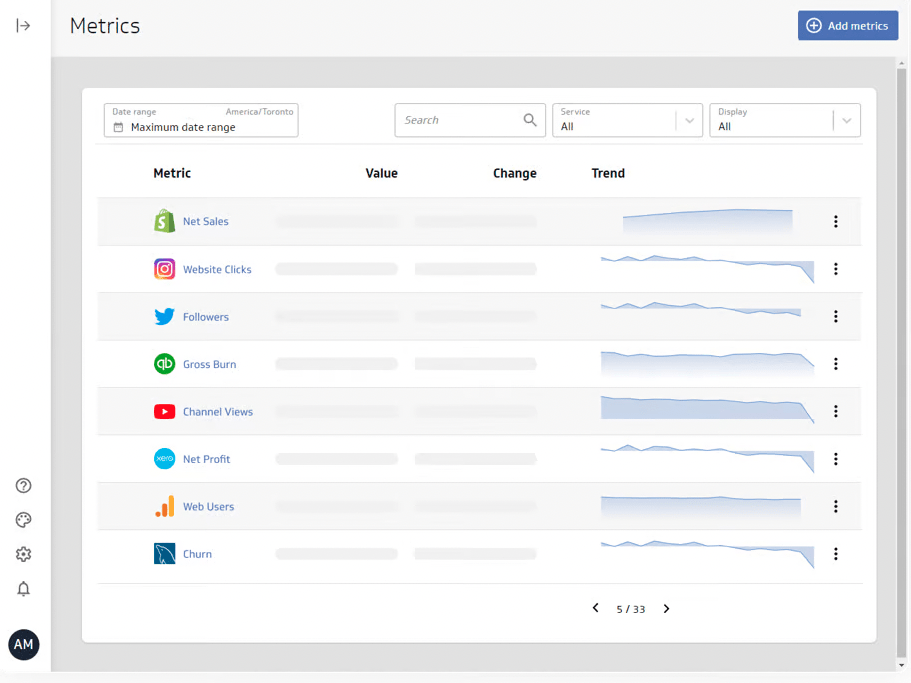
عبر كليبفوليو يُمكِّن Klipfolio المستخدمين من معالجة بياناتهم وتحويلها باستخدام صيغ متقدمة، مما يجعله خيارًا ممتازًا للفرق التي تحتاج إلى تحليل متعمق للبيانات. مع مجموعة متنوعة من خيارات التصور وواجهة سهلة الاستخدام، يتيح Klipfolio للمستخدمين صياغة تقارير جذابة بصريًا وغنية بالمعلومات يمكن مشاركتها وتضمينها عبر منصات مختلفة.
إن قدرته على التعامل مع العمليات الحسابية المعقدة والتكامل مع العديد من مصادر البيانات تميز Klipfolio عن منافسيه. إذا كان فريقك يحتاج إلى أدوات تصور البيانات التي تتفوق في إدارة الصيغ المعقدة وتوفر المرونة اللازمة للتعمق في بياناتك، فإن Klipfolio هو المرشح الأول الذي يجب أخذه بعين الاعتبار.
أفضل ميزات Klipfolio:
يمكن لمستخدمي Klipfolio الاستفادة من قوالب عائد الاستثمار المقاييس وسهولة إضافة مصادر البيانات الشائعة مثل ATS وCRM وGoogle Analytics، مما يجعل تكامل البيانات أمرًا سهلاً للغاية.
قيود Klipfolio:
تشير بعض المراجعات إلى أن عدم وجود تنبيهات مدمجة يجعل من الصعب تنسيقها خارج تقارير تصور البيانات المحددة مسبقًا. علاوة على ذلك، فإن المستخدم قاعدة المعرفة غير منظمة بشكل جيد، مما قد يخلق ارتباكًا للمستخدمين الجدد.
Klipfolio التسعير:
- مجاني: 0 دولار/شهر لمحررين اثنين
- انطلق: 49 دولارًا شهريًا لأربعة محررين
- محترف: 229 دولارًا/شهرًا ل 10 محررين
- الشركة: بدءًا من 799 دولارًا شهريًا بناءً على عدد المحررين
Klipfolio التقييمات والمراجعات:
- G2: 4.5/5 (240+ تقييم)
- كابيترا: 4.7/5 (أكثر من 180 تقييم)
6. إنفوجرام
أفضل أداة لتصور البيانات للتصورات الإبداعية
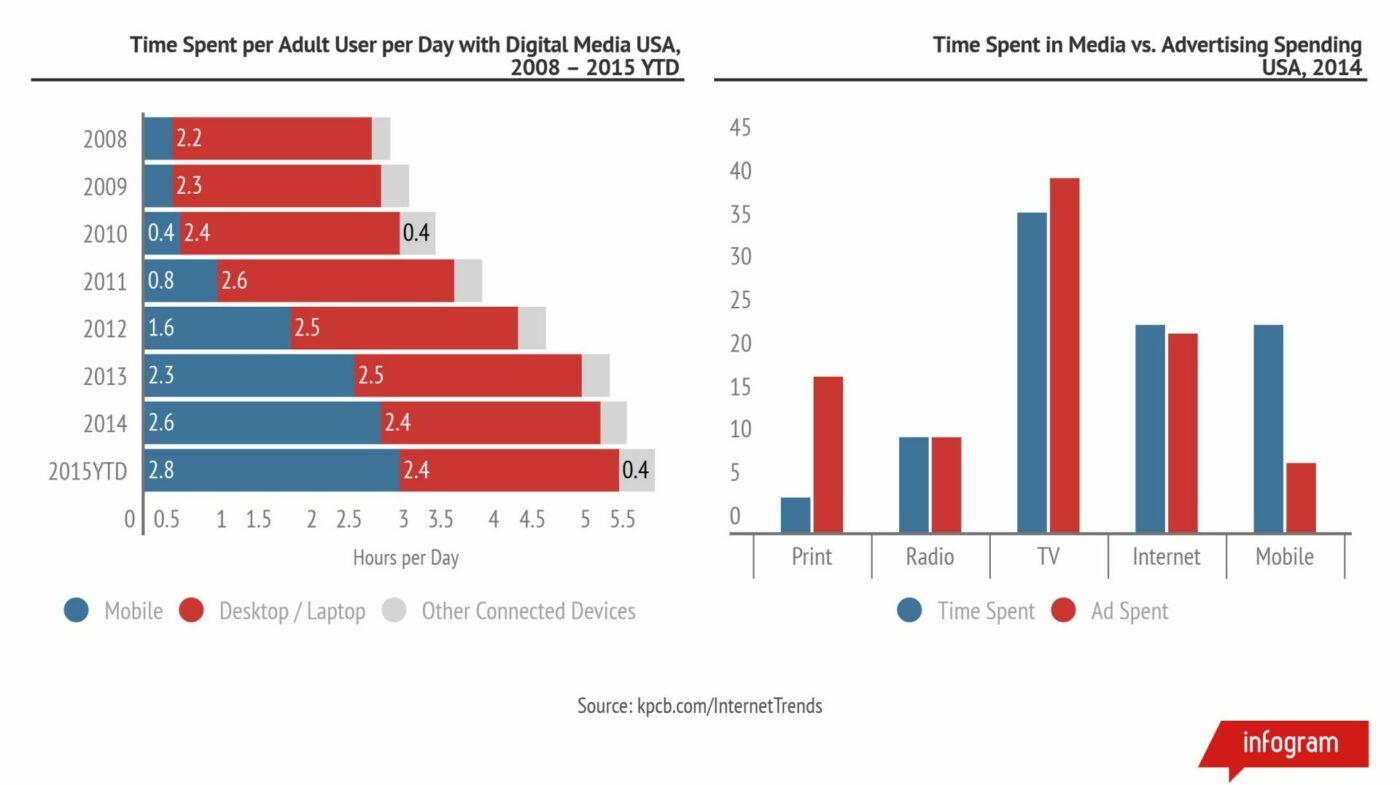
مثال على المخططات الشريطية في مخطط بياني Infogram عبارة عن منصة ديناميكية لتصور البيانات تُمكِّن المستخدمين من إنشاء تصورات مذهلة ومبتكرة بصريًا. من خلال مكتبته الواسعة من القوالب والأيقونات والرسومات والمخططات الدائرية، يمكن للمستخدمين تصميم مرئيات فريدة وجذابة تجذب انتباه جمهورهم.
كما أن واجهة المنصة سهلة الاستخدام ومحرر السحب والإفلات يجعل من السهل تصميم وتخصيص تصوراتك، حتى بالنسبة لأولئك الذين لديهم الحد الأدنى من الخبرة في التصميم. بمساعدة Infogram، يمكنك إنشاء مرئيات تفاعلية جذابة وتفاعلية تتميز عن غيرها من أدوات تصور البيانات الأخرى المذكورة هنا. إنه خيار مثالي للفرق التي تبحث عن ميزة إبداعية في سرد قصص البيانات.
أفضل ميزات #### Infogram:
تتفوق Infogram في إنشاء المخططات والرسوم البيانية التفاعلية، بالإضافة إلى إنتاج تقارير مرئية جذابة بصريًا لتصور البيانات، والصفحات ذات الصفحة الواحدة، والرسوم البيانية التي تجذب انتباه القارئ.
قيود إنفوجرام:
تقول بعض المراجعات أن هذه الأداة غير موصى بها للشركات على مستوى المؤسسات. قد يواجه المستخدمون صعوبة في دمج الخطوط وقواعد البيانات المخصصة، والحفاظ على هوية الشركة، والعدد المحدود من التراخيص المتاحة لإصدار المؤسسة.
تسعير #### Infogram:
- أساسي: 0 دولار/شهر لـ 10 مشاريع
- محترف: 19 دولارًا شهريًا ل 100 مشروع
- الأعمال: 67 دولارًا/شهرًا ل 1,000 مشروع
- الفريق: 149 دولارًا/شهرًا ل 3000 مشروع
- المؤسسات: اتصل لمعرفة الأسعار
التقييمات والمراجعات
- G2: 4.7/5 (أكثر من 160 تقييم)
- كابيترا: 4.5/5 (أكثر من 60 تقييم)
7. داتاورابر
أفضل أداة لتصور البيانات لتصورات غرفة الأخبار
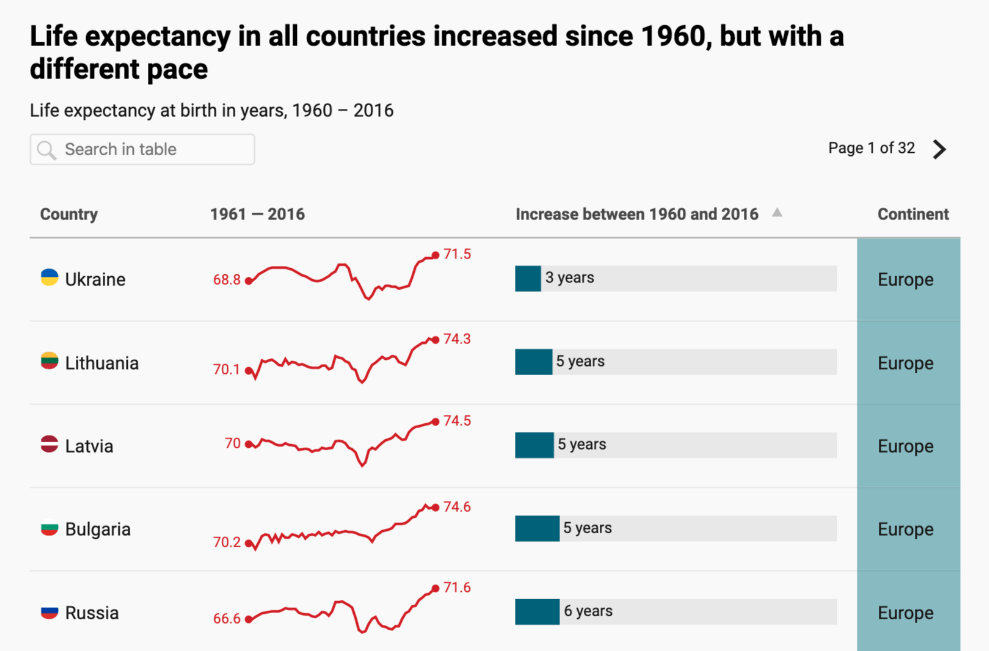
عبر داتاورابر تم تصميم Datawrapper خصيصًا لتلبية احتياجات غرف الأخبار والصحفيين. تمكّن المنصة المستخدمين من إنشاء تصورات واضحة ذات مظهر احترافي يمكن تضمينها بسهولة في المقالات والمنشورات على الإنترنت.
ومن خلال التركيز على البساطة والدقة، تضمن لك Datawrapper أن تنقل صورك المرئية رسالتك بوضوح وفعالية. تتميز المنصة بواجهة سهلة الاستخدام ومجموعة واسعة من أنواع الرسوم البيانية - من المخططات المبعثرة إلى الخرائط الجغرافية -تجعل من السهل على الصحفيين إنشاء صور مقنعة تعزز قصصهم.
أفضل ميزات Datawrapper:
يتيح Datawrapper للأشخاص غير التقنيين في فريقك إنشاء تصورات للبيانات دون الحاجة إلى أي كود برمجي. وهذا يسلح المزيد من فريقك بعلم البيانات لاتخاذ قرارات سريعة ومستنيرة.
قيود Datawrapper
تشير المراجعات إلى أن بساطة Datawrapper تأتي بتكلفة مع تصورات البيانات التفاعلية. ويذكر المستخدمون أن التطبيق يفتقر إلى الأدوات المتقدمة التي يحتاجها المحللون المحترفون - مما يجعل من الصعب تخصيصه بالكامل.
تسعير Datawrapper:
- مجانًا: 0 دولار/شهر لمستخدم واحد
- مخصص: 599 دولارًا شهريًا ل 10 مستخدمين
- مؤسسة: اتصل لمعرفة الأسعار
Datawrapper التقييمات والمراجعات:
- G2: 4.3/5 (2+ مراجعات)
- كابيترا: 5/5 (3+ مراجعات)
8. داتابوكس
أفضل أدوات تصور البيانات التفاعلية للوحات معلومات مؤشرات الأداء الرئيسية
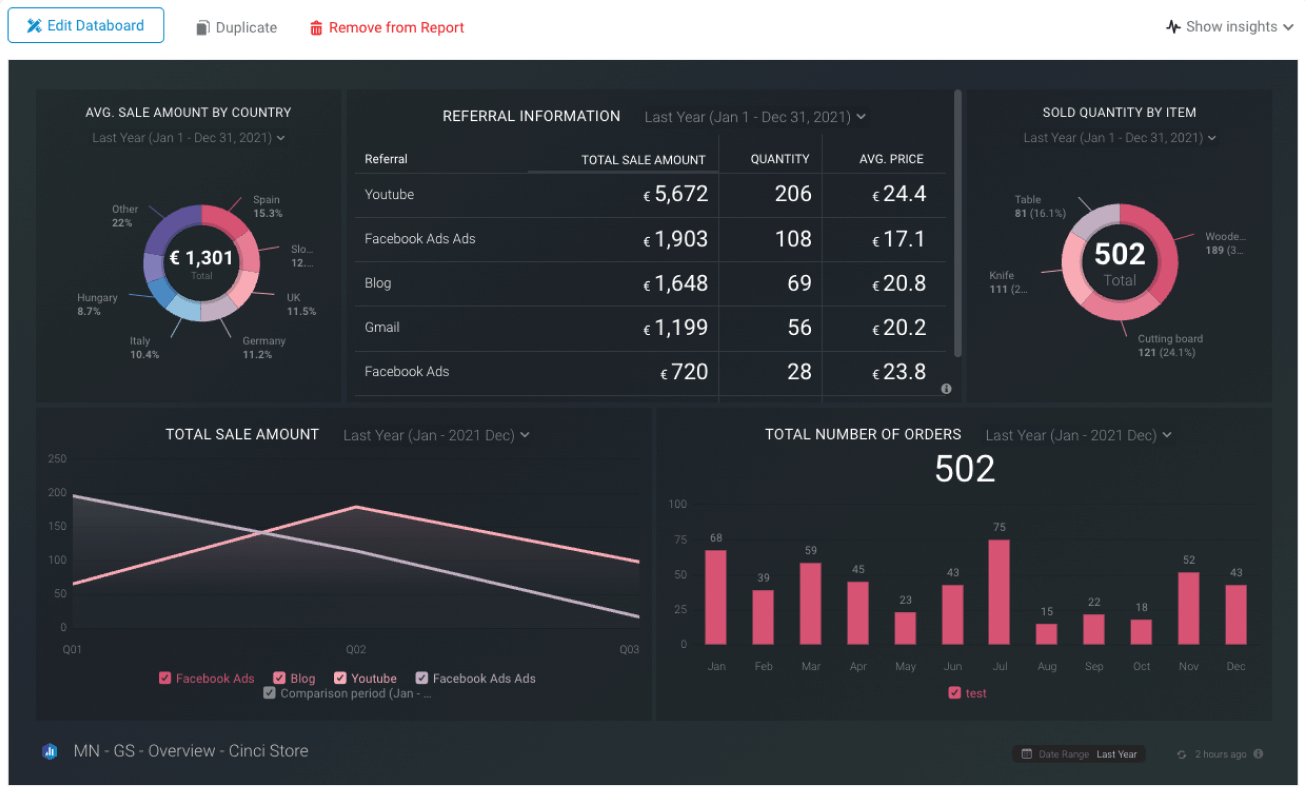
عبر صندوق البيانات Databox هو برنامج قوي لتصور البيانات مصمم ومتخصص في إنشاء لوحات معلومات شاملة لمؤشرات الأداء الرئيسية للشركات.
يتيح Databox للمستخدمين تجميع لوحات معلومات مؤشرات الأداء الرئيسية وتخصيصها بسرعة، وذلك بفضل مكتبته الواسعة من القوالب المبنية مسبقًا والتكامل السلس مع مصادر البيانات الشائعة، مما يضمن أن تكون المقاييس الرئيسية في متناول أيديهم دائمًا. من السهل تحليل البيانات باستخدام المخططات الشريطية والمخططات المبعثرة والمخططات الخطية وغيرها من الرسوم البيانية التحليلية المرئية.
تعمل تحديثات البيانات في الوقت الفعلي للمنصة وإمكانية الوصول إليها عبر الأجهزة المحمولة على تسهيل مراقبة أداء الفرق واتخاذ قرارات مستنيرة أثناء التنقل.
Databox أفضل الميزات:
يوفّر Databox تحكماً كاملاً قابلاً للتخصيص في لوحات معلومات المقاييس الرئيسية، مما يوفر لقطات يومية للأداء. يمكن للمستخدمين جدولة اللقطات لإرسالها إلى Slack والبريد الإلكتروني والمنصات الأخرى، وتساعد ميزة الأهداف في وضع تحليلات البيانات والمقاييس في سياقها.
قيود #### Databox:
يقول البعض إن عمليات التكامل في Databox تفتقر إلى التكامل مقارنةً بأدوات تصور البيانات الأخرى، مما قد يؤدي إلى بيانات غير دقيقة أو قديمة. ونتيجة لذلك، لا يمكن استخدامها كمصدر للحقيقة بلا منازع لإعداد التقارير.
تسعير Databox:
- خطة مجانية للأبد: 0 دولار/شهر لمستخدم واحد
- بداية: 72 دولارًا شهريًا لخمسة مستخدمين
- احترافية: 135 دولارًا شهريًا ل 25 مستخدمًا
- محترف: 231 دولاراً شهرياً لعدد غير محدود من المستخدمين
تقييمات ومراجعات صندوق البيانات:
- G2: 4.4/5 (180+ تقييم)
- كابيترا: 4.7/5 (180+ تقييم)
9. واتسغراف
أفضل أداة لتحليلات البيانات لتصورات التسويق

عبر ما هي الفقرة Whatagraph عبارة عن حل لتصور البيانات مصمم خصيصًا لفرق التسويق، حيث يقدم مجموعة كبيرة من الأدوات لإنشاء تقارير تسويقية جذابة بصريًا وغنية بالمعلومات.
وبفضل واجهته البديهية وقوالبه القابلة للتخصيص، يتيح Whatagraph للمستخدمين عرض أدائهم التسويقي وعائد الاستثمار بسهولة من خلال صور جذابة.
وللحصول على تصور حقيقي للبيانات، تضمن قدرة هذه الأداة على التكامل مع منصات التسويق الشائعة سير عمل مبسط وتمثيل دقيق للبيانات.
أفضل ميزات Whatagraph:
من السهل للغاية إعداد Whatagraph لإعداد التقارير، مع تكامل سريع لأدوات التسويق الرقمي. يمكن لخاصية المنشئ الذكي إنشاء تقارير كاملة بناءً على المنصات المرغوبة ومواصفات إعداد التقارير في بضع دقائق فقط.
قيود Whatagraph:
تشير مراجعات Whatagraph إلى تجارب بطء استرجاع البيانات، مما قد يكون محبطًا للمستخدمين. بالإضافة إلى ذلك، ينقطع الاتصال أحيانًا بمصادر البيانات، مما قد يتسبب في حدوث ثغرات في إعداد التقارير أو عدم الدقة.
تسعير Whatagraph:
- احترافي: 223 دولارًا شهريًا لخمسة مستخدمين
- بريميوم: 335 دولارًا شهريًا ل 10 مستخدمين
- مخصص: اتصل لمعرفة الأسعار
ما هي تقييمات ومراجعات
- G2: 4.5/5 (220 تقييم)
- كابيترا: 4.4/5 (أكثر من 80 تقييم)
10. ذكاء سحابة التسويق السحابي لقوة المبيعات
أفضل أدوات تصور البيانات للرسوم البيانية البسيطة
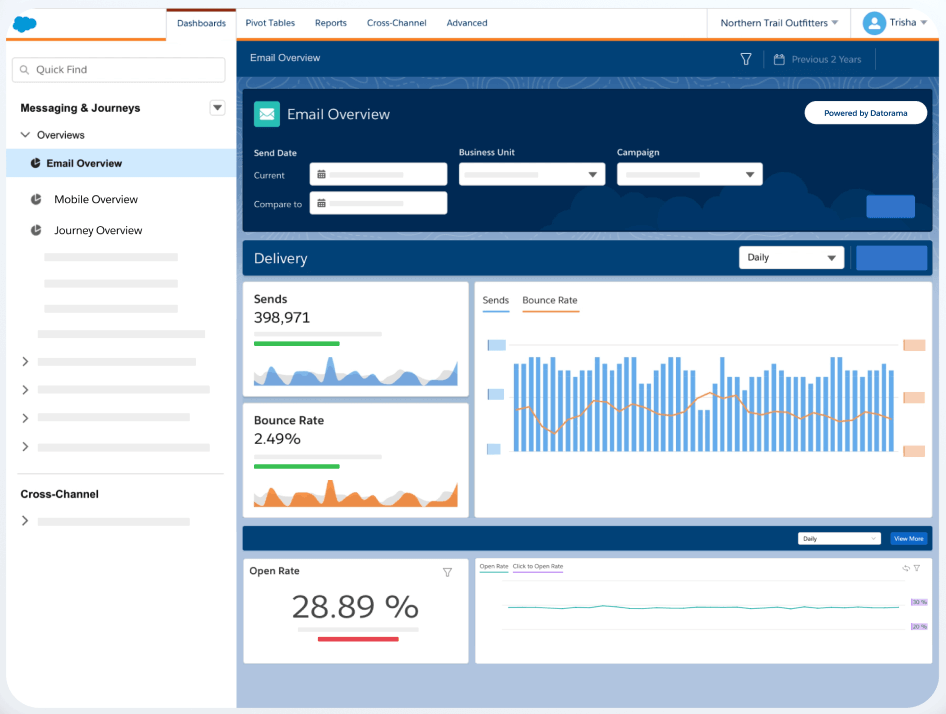
عبر فريق المبيعات تندرج Salesforce Marketing Cloud Intelligence (المعروفة سابقًا باسم Datorama) ضمن قائمة أدوات تصور البيانات سهلة الاستخدام التي تتفوق في إنشاء مخططات بسيطة وفعالة في الوقت نفسه للشركات. بفضل واجهته المباشرة ومجموعة من أنواع الرسوم البيانية سهلة الاستخدام، فهو أحد أفضل أدوات تصور البيانات لأنه يتيح للمستخدمين تحويل بياناتهم بسرعة إلى مرئيات واضحة وغنية بالمعلومات.
إن تركيز المنصة على البساطة وسهولة الاستخدام يجعلها خيارًا ممتازًا للفرق التي تبحث عن حل لا يتطلب جهدًا لإنشاء تصورات للبيانات. إذا كانت أولويتك هي إنشاء مخططات واضحة وموجزة دون تعقيد الميزات المتقدمة، فإن Datorama هو المرشح الأول لمجموعة أدوات تصور البيانات الخاصة بك.
أفضل ميزات Salesforce Salesforce Marketing Cloud Intelligence:
يتألق تطبيق Marketing Cloud Intelligence في استيراد البيانات، وتصور البيانات، وأدوات لوحة معلومات إعداد التقارير، وهي أمور ضرورية للعديد من الشركات. كما أن قدرتها على سحب مصادر البيانات المختلفة عبر تكامل واجهة برمجة التطبيقات تجعلها متعددة الاستخدامات وقابلة للتكيف مع احتياجات البيانات الفريدة.
قيود Sales00 Salesforce Marketing Cloud Intelligence:
على الرغم من نقاط قوتها، أبلغ بعض المستخدمين عن عملية إعداد معقدة وتستغرق وقتًا طويلاً باستخدام أداة التصور هذه. قد يجد المستخدمون أنفسهم يبذلون جهدًا كبيرًا في تكوين النظام الأساسي قبل أن يتمكنوا من الاستفادة الكاملة من ميزاته.
تسعير ذكاء سحابة التسويق السحابي من Salesforce:
- المبتدئين: 3,000 دولار شهرياً ل 10 مستخدمين
- النمو: 10,000 دولار شهريًا ل 20 مستخدمًا
- بالإضافة إلى: اتصل بنا لمعرفة الأسعار
تقييمات ومراجعات Salesforce Salesforce Marketing Cloud Intelligence:
- G2: 4.2/5 (أكثر من 110 تقييمات)
- Capterra: 4.3/5 (أكثر من 20 مراجعة)
أخبر القصة بأكملها في لمحة سريعة مع لوحات معلومات ClickUp
تلعب أدوات تصور البيانات دورًا حاسمًا في تبسيط المعلومات المعقدة واتخاذ القرارات المستندة إلى البيانات. تعمل الأداة المناسبة لفريقك على جعل جميع تدفقات بياناتك مركزية بسهولة وتضع أهم معلوماتك في متناول يدك.
تعرّف على كيفية استخدام لوحات معلومات ClickUp لأدوات قابلة للتخصيص، وإدارة مبسطة للموارد، ومساحة عمل موحدة لتسهيل إدارة المشاريع من نافذة واحدة.

